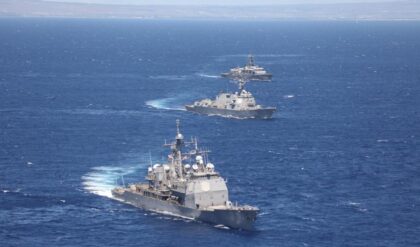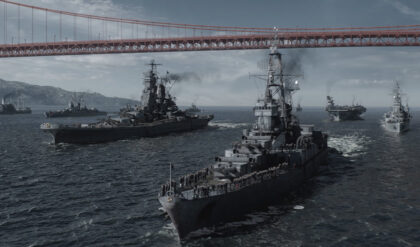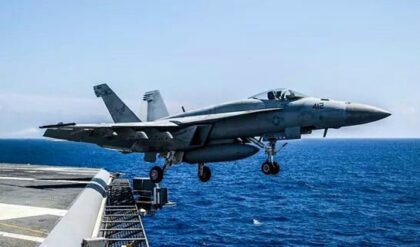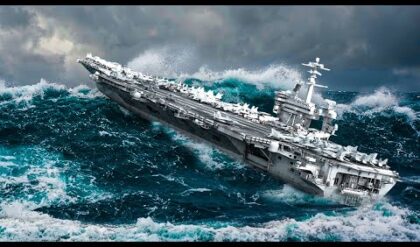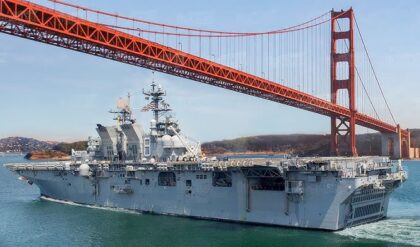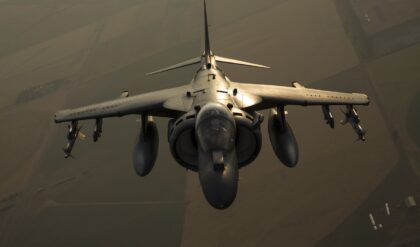The UK government has announced plans to build up to six flexible, multi-role ships to support and enable amphibious and wider littoral operations. This Multi Role Support Ship (MRSS) capability can also play a key role in generating conventional deterrence.

A landing craft deploys from the amphibious ship HMS Albion, during exercises off Norway in 2023. The UK has announced a programme for up to six new multi-role amphibious ships, designed to support future Commando operations. (Crown copyright/UK MoD, 2023) Pictured: HMS Albion as seen from one of her LCVP’s
In a press release issued on 14 May, the government announced that up to six MRSS amphibious warships would be built to support Royal Marines Commando operations, enhancing Commando capability to operate in future conflicts, including in special operations.
The press release said the MRSS ships will be globally deployable, and highly flexible to support a range of tasks, including through the operation of vehicles, aircraft, insertion craft, and uncrewed systems.
The ships also will be equipped to operate as primary casualty receiving (PCR) vessels.
The MRSS programme is now in the concept phase, with the Ministry of Defence (MoD) set to engage with industry ahead of developing the vessel design.
The programme is planned to deliver, in the early 2030s, between three and six vessels to replace six in-service platforms, namely: the Royal Navy’s (RN’s)
two landing platform dock vessels, HM Ships Albion and Bulwark; the three Royal Fleet Auxiliary (RFA) Bay-class landing ship dock auxiliary vessels, Lyme Bay, Mounts Bay, and Cardigan Bay; and the PCR/aviation support auxiliary vessel RFA Argus.
Formally announcing MRSS at the ‘First Sea Lord’s Sea Power Conference 2024’, held in London on 14-15 May, Secretary of State for Defence Grant Shapps said “Providing more flexibility, more cutting-edge technology, and better support to our amphibious and littoral strike operations, these ships will ensure [the] Royal Marines have the versatility, the heavy-lift capability, that they need.”
“The MRSS programme is an important milestone in our Future Commando Force modernisation,” he added.
The Secretary of State reiterated the plan to build up to six ships: “Three for certain, and three additional ones,” he stated.
Addressing the question of capability gap risk in the handover from current to future amphibious vessels, Shapps said “We’re going to keep the existing ships in place for our Royal Marines in the meantime.”
The press release pointed to plans that Albion and Bulwark would not be scrapped or mothballed before their scheduled out-of-service dates of 2033-2034.

The Secretary of State highlighted to the conference key elements of the MRSS acquisition strategy, noting that the MoD would use its emerging integrated procurement approach to procure the ships quickly to ensure they enter service on time.
He also underlined the importance of modularity in the MRSS design, which will enable the ships to be employed against many different use cases. “That’s exactly what we want to get out of MRSS,” he said.
As regards the ships’ operational strategy, the RN’s First Sea Lord and Chief of Naval Staff Admiral Sir Ben Key underscored the agility and adaptability MRSS will bring, enabling movement of Commando forces in the operational context of littoral manoeuvre and amphibious assault.
“MRSS is how we take Commandos … from the sea onto the land – but also [provide] that ability to go back to the sea, move quickly somewhere else and [deliver] effect again, … creating an environment in which we can either engage into the land or manoeuvre around at sea,” Adm Key told the conference. “That is part of the role these exciting new ships will play.”

In a media briefing at the conference, Adm Key expanded on the MRSS operational concept, describing how the planned approach to littoral and amphibious operations will reinforce UK conventional deterrence.
“One of the things that littoral operations will always do is shape an environment and potentially deter. So, if we show we’ve got the agility to move quickly and confidently into contested waters – and that we’re prepared to do so – and then have an effect early on, that becomes part of the deterrence messaging,” Adm Key explained.
“If necessary – [if] we then find ourselves in much more contested conflict – having the skills-sets to intervene ahead of the main force to shape the environment is an essential part of maritime warfare,” he continued.
Core to the MRSS operational concept is creating freedom of maritime manoeuvre, said Adm Key.
If such manoeuvre were threatened for example by coastal missile batteries, while destroyer-/frigate-based maritime strike could tackle this threat, a covert Commando force deployed ashore could also take on this task, disrupting capabilities to the extent of creating an operational opportunity ashore that could be exploited.
“That requires all the unique skills-sets we find in the Royal Marines Commandos today, and building into the future as part of their transformation,” said Adm Key: “but it also requires a means of getting them to work, and when they’re finished doing their work, picking them up and taking them on to their next jobs. That’s where MRSS has a role to play.”
